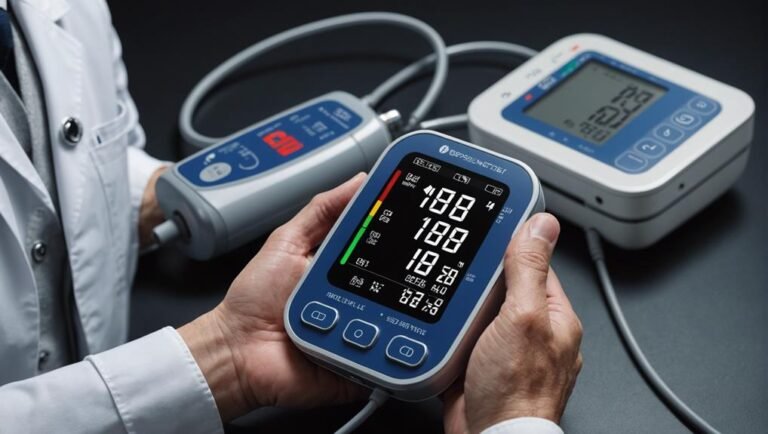Banish Muscle Cramps With Smart Solutions
Transform how you deal with muscle cramps. Begin by ensuring a proper warm-up, focusing on magnesium and potassium intake. Lactic acid buildup can trigger cramps, so hydration is key. Counter dehydration's effects by prioritizing fluid intake. Explore quick and targeted stretches for relief. Discover effective remedies for leg and back cramps. Embrace preventive measures to banish muscle cramps for good by optimizing your performance.
Key Takeaways
- Proper warm-up routines optimize muscle performance and reduce cramp risks.
- Ensure adequate magnesium and potassium intake to support muscle function and prevent cramps.
- Address lactic acid buildup through hydration and recovery techniques to avoid cramps.
- Stay hydrated to regulate electrolytes and decrease muscle irritability, reducing cramp likelihood.
- Engage in dynamic warm-up movements, prioritize stretching, and maintain hydration to prevent muscle cramps.
Common Causes of Muscle Cramps
Common causes of muscle cramps often stem from various factors such as inadequate warm-up before exercising, deficiencies in essential minerals like magnesium or potassium, and irritation due to lactic acid buildup. Proper stretching techniques can help prevent cramps by enhancing muscle flexibility and reducing tension.
Hydration plays a vital role in muscle function, and inadequate fluid intake can exacerbate cramping. Ensuring ideal hydration levels before, during, and after physical activity is essential to prevent muscle cramps. Incorporating potassium and magnesium-rich foods into your diet can also aid in maintaining proper muscle function and reducing the likelihood of cramps.
Importance of Proper Warm-up
To optimize muscle performance and reduce the risk of cramps, it's essential to prioritize a thorough and tailored warm-up routine before engaging in physical activity. Proper warm-up is vital as it helps increase blood flow to the muscles, enhancing their flexibility and reducing the likelihood of injuries.
A good warm-up should include dynamic movements that mimic the activity you're about to perform, gradually increasing in intensity. This prepares your muscles, tendons, and ligaments for the upcoming workout, making them more pliable and less prone to cramping.
Role of Magnesium and Potassium
To understand the importance of magnesium and potassium in preventing muscle cramps, consider their vital roles in muscle function and contraction. These minerals play a substantial part in maintaining muscle health and preventing cramps.
Here's why they matter:
- Dietary supplements: Ensuring adequate intake of magnesium and potassium through supplements can aid in cramp prevention.
- Cramp prevention: Magnesium and potassium are essential for muscle relaxation, making them crucial in preventing cramps.
- Exercise routines: Incorporating magnesium and potassium-rich foods in your diet can support muscle relaxation and overall muscle function during exercise.
Ensuring essential levels of these minerals can greatly contribute to reducing the occurrence of muscle cramps during physical activity.
Impact of Lactic Acid Buildup
The buildup of lactic acid during physical activity can greatly affect muscle function and contribute to the development of cramps. Lactic acid is produced when the body breaks down carbohydrates for energy without enough oxygen, leading to an acidic environment within the muscles. This acidity can interfere with muscle contractions and cause discomfort. Ensuring proper hydration is essential to help mitigate the effects of lactic acid buildup. By staying hydrated, you can support the body's ability to flush out lactic acid and maintain a more balanced pH level in the muscles. Below is a table summarizing the impact of hydration on lactic acid buildup:
| Hydration Level | Effect on Lactic Acid Buildup |
|---|---|
| Essential | Helps flush out lactic acid |
| Inadequate | Increases lactic acid buildup |
Dehydration's Effect on Cramps
Dehydration exacerbates muscle cramps by impeding the body's ability to regulate electrolyte balance, leading to increased muscle irritability and susceptibility to cramping. To counteract this effect, consider the following:
- Hydration strategies: Prioritize fluid intake before, during, and after physical activity to maintain peak hydration levels.
- Exercise benefits: Engage in regular physical activity to improve overall muscle function and promote better electrolyte balance.
- Recovery techniques: Incorporate post-exercise recovery practices like stretching, foam rolling, and proper nutrition to aid in muscle recovery and reduce the likelihood of cramps.
Connection to Reduced Blood Flow
Decreased blood flow to muscles can greatly contribute to the onset of muscle cramps. Important blood flow regulation is vital for circulatory health and muscle recovery, preventing cramps caused by reduced oxygen supply. Engaging in exercise techniques that promote circulation, such as dynamic stretching or low-impact cardio, can aid in maintaining ideal blood flow to the muscles. Additionally, ensuring good circulatory health through a balanced diet and staying hydrated can support muscle function and reduce the likelihood of cramps. Paying attention to blood flow and incorporating strategies to enhance it can be a key preventive measure against muscle cramps.
| Blood Flow Regulation | Exercise Techniques |
|---|---|
| Maintain circulation through movement | Incorporate dynamic stretching |
| Ensure proper oxygen supply to muscles | Engage in low-impact cardio |
| Support muscle recovery | Promote blood flow with regular exercise |
| Optimize nutrient delivery | Implement resistance training |
| Enhance waste product removal | Practice relaxation techniques |
Quick Stretches for Cramp Relief
Maintaining ideal blood flow to your muscles is essential for preventing cramps, and incorporating quick stretches can provide immediate relief when cramps strike. Remember these key techniques for quick relief:
- Emergency hydration is vital for addressing sudden cramps.
- Utilize specific stretching techniques tailored to the affected muscle group.
- Act promptly with stretches to relax the muscle and alleviate the cramp.
Targeted Stretches for Leg Cramps
To guarantee leg cramps effectively, promptly engage in targeted stretches tailored to the affected muscle group. When targeting leg cramps, focus on stretching the calf muscle by gently pulling your toes towards you. This action helps relieve tension and promotes muscle relaxation.
Additionally, standing up and stretching the front of your lower leg can also provide quick relief. Remember, proper hydration is key in preventing cramps, so make sure you drink an adequate amount of water throughout the day.
Effective Back Cramp Remedies
Guarantee quick relief for back cramps by incorporating effective remedies tailored to target the specific muscle group. To alleviate back cramps efficiently, consider the following expert-backed solutions:
- Dietary Supplements: Integrate magnesium and potassium-rich foods into your diet to prevent muscle deficiencies that may lead to cramping.
- Hydration: Make sure you stay adequately hydrated throughout the day to reduce the risk of cramps caused or exacerbated by dehydration.
- Yoga Postures & Muscle Strength: Practice yoga postures like the child's pose to stretch and relax the back muscles, while also focusing on strengthening exercises to improve muscle resilience against cramps.
Implementing these strategies can aid in combating back cramps effectively, offering you relief and comfort.
Preventive Measures for Muscle Cramps
For important prevention of muscle cramps, prioritize maintaining proper hydration levels throughout the day to reduce the risk of cramping episodes. Electrolyte balance is vital; make sure you replenish sodium, potassium, magnesium, and calcium lost during physical activity.
Hydration techniques like consuming electrolyte-rich beverages or sports drinks can help maintain proper electrolyte levels. Additionally, focus on a balanced diet rich in fruits, vegetables, and nuts to support overall muscle health.
Regular exercise that includes stretching and strengthening activities can also aid in preventing muscle cramps. By paying attention to your hydration, electrolyte balance, and muscle health, you can greatly reduce the likelihood of experiencing painful cramping episodes during physical exertion.
Conclusion
To sum up, by incorporating proper warm-up routines, consuming magnesium and potassium-rich foods, and staying hydrated, you can effectively banish muscle cramps and enjoy a more comfortable and active lifestyle.
Remember, prevention is key to avoiding the discomfort of cramps during workouts and daily activities.
With these smart solutions in mind, you can say goodbye to muscle cramps and hello to a stronger, more flexible body.
Keep moving forward with confidence and ease.







